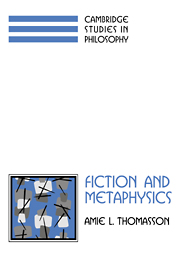Book contents
- Frontmatter
- Contents
- Acknowledgments
- Introduction: From Fiction Into Metaphysics
- Part One The Artifactual Theory of Fiction
- Foreword
- 1 If we postulated fictional objects, what would they be?
- 2 The nature and varieties of existential dependence
- 3 Fictional characters as abstract artifacts
- 4 Reference to fictional characters
- 5 Identity conditions for fictional characters
- Part Two Ontological decisions
- Notes
- Bibliography
- Index
1 - If we postulated fictional objects, what would they be?
Published online by Cambridge University Press: 23 September 2009
- Frontmatter
- Contents
- Acknowledgments
- Introduction: From Fiction Into Metaphysics
- Part One The Artifactual Theory of Fiction
- Foreword
- 1 If we postulated fictional objects, what would they be?
- 2 The nature and varieties of existential dependence
- 3 Fictional characters as abstract artifacts
- 4 Reference to fictional characters
- 5 Identity conditions for fictional characters
- Part Two Ontological decisions
- Notes
- Bibliography
- Index
Summary
If we are to postulate fictional characters at all, it seems advisable to postulate them as entities that can satisfy or at least make sense of our most important beliefs and practices concerning them. Often theories of fiction are driven not by an independent sense of what is needed to understand talk and practices regarding fiction, but rather by a desire to show how fictional characters may find their place in a preconceived ontology of possible, nonexistent, or abstract objects – to demonstrate one more useful application of the ontology under discussion, or to provide catchy and familiar examples. Instead of starting from a ready-made ontology and seeing how we can fit fictional characters into it, I suggest that we begin by paying careful attention to our literary practices so that we can see what sorts of things would most closely correspond to them. I thus begin by discussing what sorts of entities our practices in reading and discussing works of fiction seem to commit us to, and I draw out the artifactual theory of fiction as a way of characterizing the sort of entity that seems best suited to do the job of fictional characters.
WHAT FICTIONAL CHARACTERS SEEM TO BE
Fictional objects as I discuss them here include such characters as Emma Woodhouse, Sherlock Holmes, Hamlet, and Tom Sawyer – characters who appear in works of literature and whose fortunes we follow in reading those works. In our everyday discussions of literature we treat fictional characters as created entities brought into existence at a certain time through the acts of an author.
- Type
- Chapter
- Information
- Fiction and Metaphysics , pp. 5 - 23Publisher: Cambridge University PressPrint publication year: 1998



